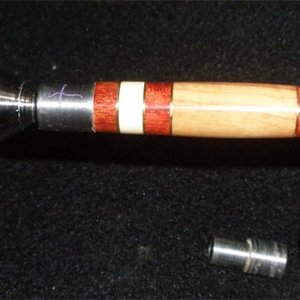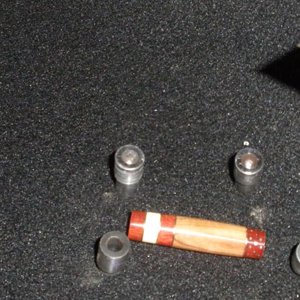AllanS
Member
Asking for someone else, who is also new to the hobby and has an issue that, quite frankly, I've no idea what it could be.
To quote:
--------------------------------
Hey there. I've been turning for about a year and a half now. When I started, I bought a starter bundle from WWR here in Canada. It included the Pen Masters no-flex mandrel live centre, and a typical 7mm MT2 pen mandrel.
Up until recently, I had been using the knurl nut included with the mandrel, in addition to the live centre. I recently discovered a flex in my mandrel, so I replaced it and did some more research on how to use the damn thing correctly.
The problem: Every time I use the mandrel and live centre the way it's intended to be used, I either have to tighten it to the point where the tension is causing distortion on my slimline bushings and causing intentions on my pen blanks, or there isn't enough pressure on the blanks and they free spin with the slightest pressure from my chisels. This issue applies to both my HHS chisels, and my TC scraper chisels.
I have also noticed that the bushings are creating indents and gauges on the mandrel itself, causing them to get suck and require considerable amounts of force to remove them.
I have found this issue on several densities of hardwoods, acrylic, and poly resin pen blanks.
Has anyone else run into this issue, or do you have any recommendations on how to prevent or fix this problem?
Side note, I typically use diamond paddles to sharpen my HHS chisels. I don't have the capacity to use a bench grinder at this time. While using the knurl nut, I had no problems with free spinning, only warping of my mandrel and in turn, slightly misshapen pens.
--------------------------------
Now he's running with a mandrel saver vis-a-vis "Pen Masters no-flex" and it certainly doesn't seem like his tools are dull (from a followup conversation). He'd been briefly using the mandrel-saver with the nut in place (thank god I'm not the only one who made that mistake) but it looks like he's swapped out the mandrel and has been using it correctly. A follow up conversation said that he's not seeing this issue when he's back to typical nut/live center use.
Any of the far more experienced masters on here have an idea? 'Cause I just can't see what might be causing this.
Thanks
To quote:
--------------------------------
Hey there. I've been turning for about a year and a half now. When I started, I bought a starter bundle from WWR here in Canada. It included the Pen Masters no-flex mandrel live centre, and a typical 7mm MT2 pen mandrel.
Up until recently, I had been using the knurl nut included with the mandrel, in addition to the live centre. I recently discovered a flex in my mandrel, so I replaced it and did some more research on how to use the damn thing correctly.
The problem: Every time I use the mandrel and live centre the way it's intended to be used, I either have to tighten it to the point where the tension is causing distortion on my slimline bushings and causing intentions on my pen blanks, or there isn't enough pressure on the blanks and they free spin with the slightest pressure from my chisels. This issue applies to both my HHS chisels, and my TC scraper chisels.
I have also noticed that the bushings are creating indents and gauges on the mandrel itself, causing them to get suck and require considerable amounts of force to remove them.
I have found this issue on several densities of hardwoods, acrylic, and poly resin pen blanks.
Has anyone else run into this issue, or do you have any recommendations on how to prevent or fix this problem?
Side note, I typically use diamond paddles to sharpen my HHS chisels. I don't have the capacity to use a bench grinder at this time. While using the knurl nut, I had no problems with free spinning, only warping of my mandrel and in turn, slightly misshapen pens.
--------------------------------
Now he's running with a mandrel saver vis-a-vis "Pen Masters no-flex" and it certainly doesn't seem like his tools are dull (from a followup conversation). He'd been briefly using the mandrel-saver with the nut in place (thank god I'm not the only one who made that mistake) but it looks like he's swapped out the mandrel and has been using it correctly. A follow up conversation said that he's not seeing this issue when he's back to typical nut/live center use.
Any of the far more experienced masters on here have an idea? 'Cause I just can't see what might be causing this.
Thanks









